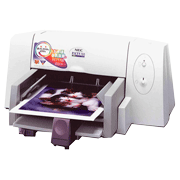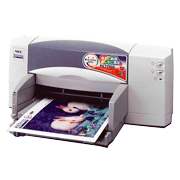In September 1998, NEC announced two A4 color inkjet printers: the PICTY700, which was still affordably priced despite having six ink colors, and the PICTY900, a high-speed printer with a top color printing speed of five pages per minute. Both printers supported USB connections and delivered print quality on par with photographs. They also met a wide range of image processing needs because they came standard with a multi-page zoom printing function as well as two very convenient software packages for creating greeting cards, banners, and signs as well as calendars.
- The printers had the following features:
- (1)Interfaces
- The PICTY900 came standard equipped with a USB port, while the PICTY700 supported USB with an optional USB printer cable. USB support meant the printers could be connected and unconnected with the ease of a power cord without any special installation. It also meant notebook computers could be hooked up to the printers in a moment for immediate printing when on the road.
- (2)High-speed, high-quality printing
- The PICTY700 printed in color at 1.7 pages per minute and in monochrome at 5 pages per minute. It also had a Photo Print mode that printed at a maximum resolution equivalent to 1200 x 600 dpi. The PICTY900 printed in color at 5 pages per minute and in monochrome at 8 pages per minute. The Super Photo Print mode, which used Japanese particle ink, printed at a maximum resolution equivalent to 1200 x 1200 dpi.
- (3)Wide range of printed materials
- Easy creation of large posters and calendars
These printers were the first Japanese A4 printers to have a multi-page zoom printing feature that enlarged the print data and printed it on several pages to make up one large print. The feature could be used to create large posters 16 times the size of an A4 page (4 horizontal x 4 vertical). - Banners and signage
The printers could make banners and signage by printing on long rolls that were A4 wide. - (4)Network support
- NEC offered three types of optional LAN adapters, enabling the printers to be directly connected into network environments.



